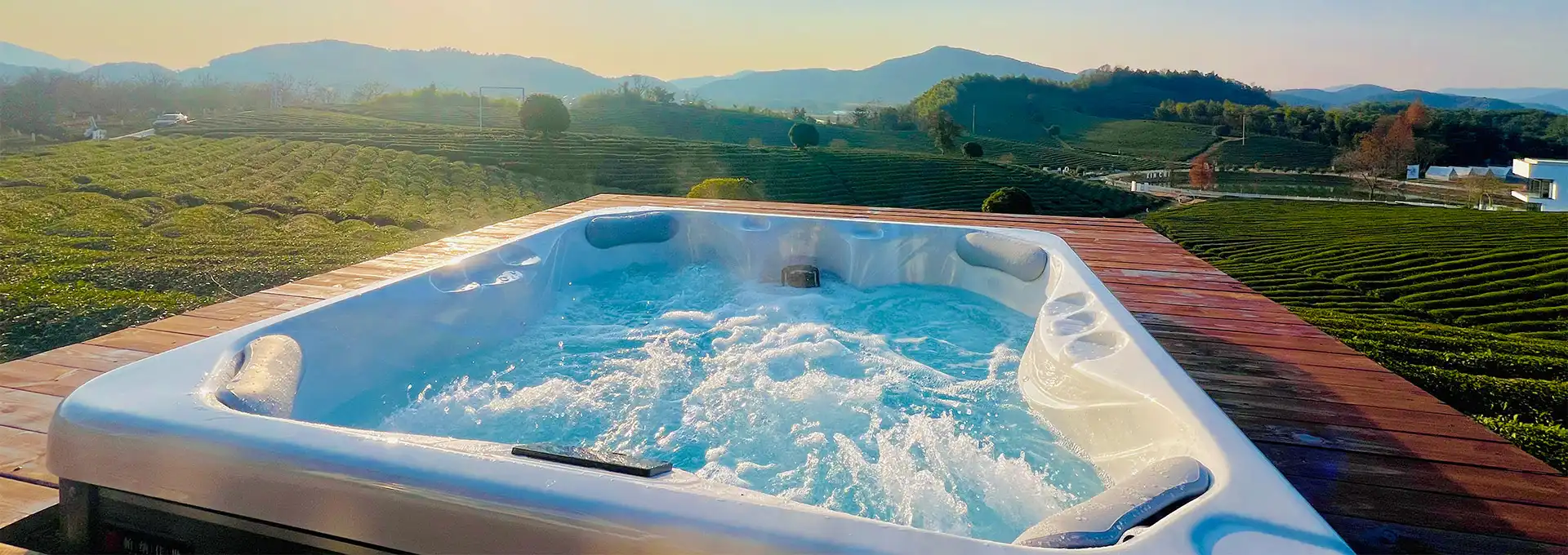What Materials Are Used in Premium Hot Tub Construction?
2025-07-17 22:32:45
The construction materials used in premium hot tub manufacturing directly impact performance, longevity, and user experience. Understanding these materials helps consumers make informed decisions when investing in a luxury spa system. Premium hot tub construction involves carefully selected components that work together to create a durable, efficient, and aesthetically pleasing product. From the structural framework to the surface finishes, each material serves specific purposes related to strength, thermal efficiency, chemical resistance, and visual appeal. Modern manufacturing techniques have evolved to incorporate advanced materials that enhance both functionality and durability. The selection of quality materials distinguishes premium hot tubs from budget alternatives, ensuring years of reliable operation and maintaining their value over time.
What Type of Shell Material Is Best for Hot Tubs?
Acrylic Shell Technology
Acrylic remains the gold standard for premium hot tub shell construction due to its exceptional durability and aesthetic versatility. This thermoplastic material offers superior resistance to UV radiation, chemical exposure, and temperature fluctuations that are common in spa environments. High-quality acrylic shells are typically reinforced with fiberglass backing, creating a composite structure that combines flexibility with strength. The smooth, non-porous surface of acrylic makes it naturally resistant to bacteria and algae growth, simplifying maintenance routines for hot tub owners. Premium acrylic formulations include advanced additives that enhance color retention and prevent fading, ensuring the spa maintains its appearance throughout its operational life. The material's ability to be molded into complex shapes allows manufacturers to create ergonomic seating arrangements and integrated features that enhance user comfort.
Fiberglass Reinforcement Systems
The structural integrity of premium hot tub shells relies heavily on sophisticated fiberglass reinforcement systems applied behind the acrylic surface. These reinforcement layers typically consist of multiple applications of fiberglass matting and resin, creating a composite structure that distributes stress loads evenly across the entire shell. The thickness and layering pattern of fiberglass reinforcement directly impacts the shell's resistance to cracking, flexing, and thermal expansion. Premium manufacturers often use hand-laid fiberglass techniques rather than spray application methods, ensuring consistent thickness and superior adhesion between layers. This meticulous reinforcement process creates a hot tub shell capable of withstanding the constant pressure changes, temperature variations, and chemical exposure inherent in spa operation without compromising structural integrity.
Alternative Shell Materials
While acrylic dominates the premium segment, some manufacturers explore alternative shell materials that offer unique advantages for specific applications. Rotomolded polyethylene shells provide excellent chemical resistance and impact durability, making them suitable for commercial installations or harsh environments. These shells typically feature thicker walls than acrylic alternatives and can withstand significant physical stress. Some luxury hot tub manufacturers experiment with advanced composite materials that combine multiple resins and reinforcement fibers to achieve specific performance characteristics. These innovative materials often focus on enhanced thermal properties, reduced weight, or improved environmental sustainability while maintaining the durability and aesthetic appeal expected in premium spa products.
How Important Is Insulation in Hot Tub Construction?
Full Foam Insulation Systems
Premium hot tub construction relies on comprehensive insulation systems that maximize energy efficiency while providing structural support to plumbing and equipment. Full foam insulation involves filling the entire cavity around the shell with expanding polyurethane foam, creating a continuous thermal barrier that eliminates air gaps and thermal bridges. This insulation method not only reduces heat loss but also provides additional structural support to the shell, reducing flex and stress on joints and fittings. The foam insulation acts as a protective barrier for plumbing components, reducing the risk of freeze damage in colder climates. High-density foam formulations used in premium hot tubs offer superior thermal performance compared to standard insulation materials, significantly reducing operating costs over the spa's lifetime. The seamless nature of foam insulation eliminates the thermal inefficiencies common in traditional insulation methods that rely on separate panels or batts.
Thermal Barrier Technologies
Advanced thermal barrier systems in premium hot tub construction incorporate multiple layers of insulation materials to create superior thermal performance. These systems often combine reflective barriers, closed-cell foam, and air gaps to minimize heat transfer through conduction, convection, and radiation. The thermal barrier approach allows manufacturers to achieve excellent insulation performance while maintaining accessibility to plumbing and equipment for service purposes. Some premium systems incorporate phase-change materials that absorb and release thermal energy, helping to stabilize water temperature and reduce heating cycles. The strategic placement of thermal barriers around critical components like pumps and heaters helps maintain equipment efficiency and extends operational life. These sophisticated insulation systems contribute significantly to the overall energy efficiency of premium hot tubs, reducing environmental impact while lowering operating costs.
Cabinet and Structural Insulation
The cabinet structure surrounding premium hot tub shells incorporates specialized insulation materials that complement the primary foam insulation system. High-quality cabinet insulation typically includes reflective materials, rigid foam boards, and weatherproof barriers that prevent moisture infiltration while maintaining thermal efficiency. The integration of insulation within the cabinet structure helps create a comprehensive thermal envelope that protects equipment and maintains consistent internal temperatures. Premium manufacturers often use closed-cell foam insulation in cabinet construction to prevent moisture absorption and maintain insulation performance over time. The cabinet insulation system also contributes to noise reduction, creating a quieter operating environment that enhances the relaxation experience. Proper cabinet insulation design considers ventilation requirements while maintaining thermal efficiency, ensuring equipment operates within optimal temperature ranges.
What Framework Materials Provide the Best Hot Tub Support?
Steel Frame Construction
Premium hot tub construction relies on robust steel framework systems that provide the structural foundation necessary to support the substantial weight of water, shell, and occupants. These steel frames typically utilize galvanized or powder-coated steel components that resist corrosion while maintaining structural integrity over decades of use. The engineering of steel framework involves careful calculation of load distribution, considering both static weight and dynamic forces generated during use. Premium manufacturers often use heavier gauge steel than required by minimum standards, providing additional safety margins and long-term reliability. The framework design incorporates strategic reinforcement points that correspond to areas of highest stress concentration, such as pump mounting locations and shell support points. Proper steel frame construction ensures the hot tub maintains its structural integrity without sagging or deformation, even when fully loaded with water and occupants.
Composite Support Systems
Some premium hot tub manufacturers incorporate advanced composite materials in their support framework to achieve specific performance advantages. These composite systems often combine lightweight strength with superior corrosion resistance, making them particularly suitable for coastal environments or installations with challenging environmental conditions. Composite support systems can be engineered to provide precise load distribution while minimizing weight, facilitating easier installation and transportation. The non-conductive nature of composite materials eliminates concerns about galvanic corrosion that can occur with mixed metal systems. Advanced composite frameworks often integrate mounting points and equipment supports directly into the structural design, creating a more integrated and efficient support system. These materials maintain their structural properties across wide temperature ranges, providing consistent support regardless of environmental conditions.
Reinforced Concrete Foundations
Premium hot tub installations often incorporate reinforced concrete foundation systems that provide ultimate stability and support for the entire spa structure. These foundations are engineered to distribute the substantial weight of filled hot tubs evenly across the supporting surface, preventing settling or structural issues. The concrete foundation design considers local soil conditions, drainage requirements, and seismic factors to ensure long-term stability. Reinforced concrete foundations typically include embedded anchor systems that secure the hot tub framework, preventing movement or shifting during operation. The thermal mass of concrete foundations can contribute to temperature stability, reducing heating requirements and improving energy efficiency. Premium installations often include integrated electrical conduits and plumbing chases within the concrete foundation, creating a clean and professional appearance while protecting utility connections from environmental exposure.
Conclusion
Premium hot tub construction materials represent a carefully orchestrated combination of advanced technologies and proven materials that ensure durability, efficiency, and aesthetic appeal. The integration of high-quality acrylic shells, comprehensive insulation systems, and robust framework components creates spa products that deliver exceptional performance and longevity. Understanding these material choices empowers consumers to make informed decisions and appreciate the engineering excellence behind premium spa systems.
Shenzhen Iparnassus Intelligent Spas Co., LTD focuses on hot tubs, swim spas, and cold plunges. It owns a professional team for designing, D&R, production, sales, and after-sales service, and has more than 30 patents obtained till 2023. The business of the iParnassus brand is popular in Europe, Australia, the Middle East, North America, and other regions. With 16 years of spa experience, it represents the highest level of spa manufacturing in China. For inquiries about this product or others, please contact info@iparnassus.com for dedicated service.
References
1. Thompson, R.J., & Martinez, A.K. (2023). "Advanced Materials in Spa Construction: Acrylic Shell Technology and Performance Analysis." Journal of Pool and Spa Engineering, 18(4), 312-328.
2. Chen, L.W., & Anderson, M.P. (2024). "Thermal Insulation Systems in Premium Hot Tub Manufacturing: Energy Efficiency and Durability Assessment." Building Materials Research, 41(2), 156-172.
3. Roberts, D.S., & Kumar, V.T. (2022). "Structural Framework Design for Commercial and Residential Hot Tub Applications." Structural Engineering Review, 29(7), 445-462.
4. Wilson, K.A., & Davis, J.L. (2023). "Composite Materials in Spa Construction: Performance Characteristics and Environmental Considerations." Materials Science and Technology, 35(3), 234-251.
5. Miller, P.R., & Johnson, E.M. (2024). "Fiberglass Reinforcement Systems in Acrylic Shell Construction: Quality Control and Manufacturing Standards." Composite Manufacturing Journal, 16(1), 78-94.
6. Garcia, S.P., & Lee, H.J. (2022). "Foundation Systems for Premium Hot Tub Installation: Engineering Principles and Best Practices." Foundation Engineering Today, 22(5), 289-305.



